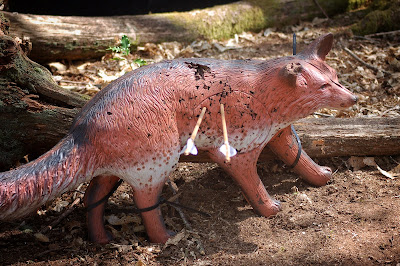Mike Bodnar adds another
string to his bow and spends a day with some
 |
| Katniss Everdeen on target in The Hunger Games. Image: fencing.net |
Katniss Everdeen, William Tell or Robin Hood, they’ve all pulled a bowstring for our entertainment, and maybe to save the world while they were at it – or in the case of the elf Legolas, Middle Earth.
As a result we know only that arrows are deadly, are shot from a bow or crossbow, and either find their target accurately or rain terrifyingly down in their hundreds from the skies above.
From these brief but exciting small- and big-screen encounters we are therefore aware of the basic principles of the bow and arrow, but there are aspects of filmic archery that are nearly always wrong, as I learned from spending a day with some members of Surrey’s Longbow Heritage archery club recently.
 |
| Gerry May (aka 'Lord Raven'). Image: Mike Bodnar |
The bows, he explains, were only as good as their strength when bent, so real archers would always carry them unstrung.
‘They’d string their bows when they were ready to shoot, but not before,’ he explains. 'Whereas if you keep it strung it will stay bent, and then you lose power.’
And that’s another thing he tells me: arrows are always shot. ‘You fire a gun but shoot an arrow.’ I have a lot to learn, but I am building up my archery knowledge in perhaps the most pleasant way possible – by strolling through some gorgeous deep-Surrey woodland on a perfect late spring day with the sun shafting through the trees lighting up the bluebells, and occasionally spotlighting an animal target.
 |
| A rubbery fox. Image: Mike Bodnar |
It’s not so jolly for the targets however. Known as 3-D field archery targets, most of them are quite convincing (although I can’t vouch for the dragon) but are actually made of a durable rubbery compound.
Each target point is identified by a number staked in the ground, so in a way it’s rather like playing a round of golf except that you’re permanently in the rough. And, unlike golfing greens which are usually out in the open, these targets have been cunningly placed deep in the wood and, occasionally, even behind foliage. But even though they can be almost hidden, finding the next target point is quite easy since the trail is marked – appropriately – with arrows.
 |
| Not just for Merry Men; Jurga Artse shows her skills. About one in three archers is female. Image: Mike Bodnar |
As we approach the first target point Gerry tells me how the scoring works. ‘You get to shoot three arrows per target. In the ground, at different distances from the target there are pegs: a red one, white one and a blue one. The red is always furthest from the target, the white a bit closer, and the blue closest of all.’
Which means that if all your arrows hit home while your foot is against the red peg you can score maximum points, but the scoring decreases the closer you get to the target. If your first arrow misses then you must move to the white peg, and again if you don’t find the target you move to the blue peg.
 |
| Gerry gives novice Steve some tips. Image: Mike Bodnar |
‘It’s called “nocking,”’ Gerry says. ‘When you put the notch onto the bow string your arrow is nocked.’ He reminds Steve not to do this before placing his foot against the peg.
The fact that an arrow could seriously injure or even kill someone is the reason I’m not having a go myself; the club rules simply don’t allow it. Even a novice archer has to first be signed-off by a club senior that they can shoot straight before being allowed to compete, hence I am purely an observer for the day.
As we meander through the wood – Gerry and his Merry Men – I realise that there’s quite a science to designing a course like this. For one thing- as later confirmed by club secretary Carol Pearce who laid out the course – when shooting at a target you shouldn’t be facing any other target point or the trail, so that should an arrow somehow ‘go bush’ there is little chance of it finding a human target.
Also, the 70-member club uses the wood by private arrangement with a local landowner; it‘s not open to the public or ramblers, so the chances of strangers wandering into the kill zone are minimal.
 |
| The Longbow Heritage club house. Image: Mike Bodnar |
Disgruntled with his score
(Steve was happier with his), Gerry leads us back to the ‘clubhouse’ – a small converted
farm shed on the edge of a paddock – for lunch. Club members sit around in the
sunshine and talk archery (naturally), compare bows, discuss arrows, and so on.
It’s all very genial. Secretary Carol busies herself in the tiny kitchen making
bacon and sausage butties. Nearby there is a practice target in the field which
is put to good use by those not venturing into the woods.
 |
| A quiver of arrows Image: Mike Bodnar |
 or sale. He tells me however that after buying it he discovered it wasn’t any good. ‘I took it to Carol and showed her and she said it was rubbish, get rid of it!’ With her expert advice he found a more suitable weapon.
or sale. He tells me however that after buying it he discovered it wasn’t any good. ‘I took it to Carol and showed her and she said it was rubbish, get rid of it!’ With her expert advice he found a more suitable weapon. 

